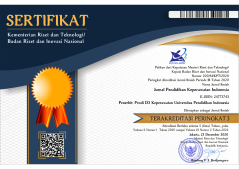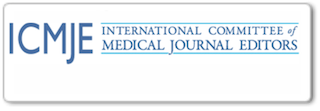PENGARUH FAKTOR DEMOGRAFI TERHADAP QUALITY OF NURSING WORK LIFE (QNWL) PERAWAT RUMAH SAKIT MUHAMMADIYAH BANDUNG
Abstract
Perawat sebagai SDM dengan jumlah terbanyak di rumah sakit,mempunyai peranan penting dalam pencapaian tujuan dan kualitas rumah sakit. Untuk bisa mencapai tujuan rumah sakit memerlukan perawat yang memiliki komitmen organisasi dan kinerja yang baik, Quality of Nursing Work Life (QNWL) adalah salah satu faktor penting yang mempengaruhi komitmen dan kinerja perawat. Permasalahan perawat di Rumah Sakit Muhammadiyah Bandung (RSMB) terindikasi memiliki Quality of Nursing Work Life (QNWL) kurang baik yang berdampak pada kurang baiknya komitmen dan kinerja perawat. Oleh karena itu, diperlukan penelitian lebih lanjut terkait QNWL perawat RSMB. Penelitian ini bertujuan untuk mengetahui gambaran QNWL perawat RSMB, mengetahui gambaran demografi beserta pengaruhnya terhadap QNWL perawat RSMB Penelitian deskriptif cross- sectional survey ini, melibatkan 94 perawat yang diambil dengan cara kuantitatif. Data dikumpulkan dengan kuesioner, dan dianalisis menggunakan uji non-parametrik Mann Whitney. Penelitian ini dilakukan pada akhir bulan Januari 2017 di Rumah Sakit Muhammadiyah Bandung. ‘Hasil penelitian ini menunjukkan bahwa perawat di RSMB memiliki nilai QNWL secara keseluruhan dan dimensi-dimensi QNWL yang berada dalam kategori baik. Hasil penelitian ini juga menunjukkan bahwa tiga faktor demografi berpengaruh signifikan terhadap QNWL perawat, yaitu: faktor jenis kelamin (p=0.04), umur (p=0.006) dan lama bekerja sebagai perawat (p=0.009). Sedangkan, dari segi status pernikahan (p=0.71), tingkat pendidikan (p=0.71) dan lama bekerja sebagai perawat di RSMB (p=0.173) tidak berpengaruh signifikan. Implikasi penelitian ini adalah perlu adanya upaya perbaikan komponenkomponen dan faktor-faktor QNWL yang masih bermasalah. Kunci utama terletak pada upaya penerapan sistem penilaian kinerja perawat yang dihubungkan dengan jenjang karir perawat dan sistem penggajian perawat.
ABSTRACT
Nurses as the highest number of human resources in hospital have an important role in achieving the goals and qualities of hospital. In order to achieve the goals, hospitals require nurses who are committed to the organization and have a good performance. Quality of Nursing Work Life (QNWL) is one of the important factors which affect the nurses’ organizations’ commitment and performance. The problem of nurses at Muhammadiyah Hospital Bandung (RSMB) can be identified from the low number of nurses’ QNWL which affect the nurses’ commitment and performance. Therefore, further researches related to QNWL in RSMB nurses are needed. This study aimed to investigate the nurses’QNWL in RSMB, discover demographic factors and its influence on nurses’ QNWL in RSMB. This descriptive cross-sectional survey was conducted on 94 nurses taken by a quantitative manner. The Data were collected through questionnaire and analyzed using non-parametric test of Mann Whitney. This research was conducted at the end of January 2017 at Muhammadiyah Hospital Bandung.
The results of this research showed that nurses at Muhammadiyah Hospital Bandung overall have a good level of Quality of Nursing Work Life (QNWL) in each dimensions. The results also showed that three demographic factors significantly influence QNWL of nurses, which are gender (p = 0:04), age (p = 0.006) and length of work as a nurse (p = 0.009). Meanwhile, there is no significant relationship in terms of marital status (p= 0.71), educational level (p= 0.71) and length of work as nurses in RSMB (p=0.173). The implication of this research is the need to improve the problematic components dan factors of QNWL. The main key lies in promoting the evaluation performance system linked to the nurses’ career development opportunities and nurses’ salary.
Keywords
Full Text:
PDFReferences
Almalki, M.,et all (2012). Quality of work life and turnover intention in primary healthcare organisations: A cross-sectional study of registered nurses in Saudi Arabia. Queensland University of Technology: Faculty of Health. PhD Thesis.
Almalki, M., Fitzgerald, G., & Clark, M. (2012). Quality of work life among primary health care nurses in the Jazan region, Saudi Arabia: a cross-sectional study. Human Resources for Health, 10(10), 30.
Aryansah, I., Kusumaputri, E.S. (2013). Iklim Organisasi dan Kualitas Kehidupan Kerja Karyawan. Humanitas (Jurnal Psikologi Indonesia), 10(1): 75-86.
Brooks, B. A., Anderson, M. A. (2005). Defining Quality of Nursing Work Life. Nursing Economics, 23(6), 279,319-326.
Bjork, I.T., Samdal, G.B., Hansen,B.S., Torstad,S., Hamiltom,G.A. (2007). Job satisfaction in a Norwegian population of nurses: A questionnaire survey. International Journal of Nursing Studies, 44 (5), 747-757.
Chrisienty,Wenda. (2015). Pengaruh Quality Of Work Life Terhadap Komitmen Organisasional Karyawan Di CV Sinar Plasind. AGORA, 3(2), 483–490.
Clarke, P., Brooks,B. (2010). Quality of nursing worklife: Conceptual vlarity for the future. Nursing Science Quarterly, 23 (4), 301-305.
Dargahi, H., Gharib, M., Goudarzi, M. (2007). Assessment of the nurses’ quality of work life in hospitals affliated to Teheran Medical Sciences University. HAYAT: The J Tehran FacNurs & Midwifery, 13, 13-21.
Dargahi, H., Changizi, V., Jazayeri, G.E. (2012). Radiology employee’s quality of work life. Acta Medica Iranica Journal, 50 (4), 250-230.
Davis, K., Newstroom. (2004). Perilaku dalam organisasi. Erlangga: Jakarta.
Fields, Mitchel W., and James W. Thacker. (1992).Influence of Quality of Work Life on Company and Union Commitment. Academy of Management journal, 35(2), 439-450
Gray and Smeltzer. (1990). An Analisis of Quality of Work Life (QWL) and career related variable. American Journal of Applied Sciences, 3 (12), 2151-2159.
Greenberg, Jerald dan Baron, Robert A. (2000). Perilaku Organisasi. Jakarta : Prentice Hall
Hanlon, M., Gladstein, D. (1984). Improving the quality of work life in hospitals: A case study. Hospital and Helath Services Administration, 29 (5), 94-107.
Heidari, A., Askary, P., & Saedi, S. (2012). Relationship between quality of work life, organizational health and commitment with job satisfaction. Life Science Journal, 9(3).
Heidari, A., Enayati, A., Hedayatio, A. (2010). Quality of work life and job satisfaction among the nurses of Tehran university of medical sciennces. Dena Journal, 5 (4), 28-37
Hsu, M.Y., Kernohan, G. (2006) .Dimensions of hospital nurses' quality of workinglife. J AdvNurs, 54(1):120–131.
Huang, T., Lawler, J., & Lei, C. (2007). The Effects Of quality of Work Life On Commitment And Turnover Intention. Social Behavior and Personality, 35(6), 735-750. Retrieved from http://search.proquest.com/docview/209905760?accountid=25704
Ilyas. (2002). Manajemen Sumber Daya Manusia. FKM UI : Depok.
International Council of Nurses (1965). Position statements. Geneva: ICN
Khaghanizadeh, M., Ebadi, A., Cirati, N.M., Rahmani, M. (2008). The study of relationship between job stress and quality of work life of nurses in military hospitals. Journal of Military Medicine, 10(3), 175-184.
Khoerullah, Heru. (2015). Hubungan Quality Of Work Life Perawat Dengan Kepuasan Pasien Di RSUD Berkah Pandeglang. Tesis. Fakultas Keperawatan Universitas Padjajaran: Bandung.
Lazarova, M. B. (2004). The role of organizational career development programs, work /life balance programs, and commitment to career and personal life for retention of professional employees (Order No. 3117615). Available from ProQuest Dissertations & Theses Global: The Humanities and Social Sciences Collection. (305154239). Retrieved from http://search.proquest.com/docview/305154239?accountid=25704.
Mangkunegara. (2003). Perencanaan dan Pengembangan SumberDaya Manusia.Bandung: Refika Aditama.
Melia, I. (n.d.). Analisis Komitmen Organisasi Melalui Faktor Quality Of Work Life ( Studi Kasus Fakultas Ekonomi dan Manajemen Institut Pertanian Bogor ), II(3), 79–88.
Moradi, T., Maghaminejad, F., & Azizi-fini, I. (2014). Quality of working life of nurses and its related factors. Nurse Midwifery Study, 3(2).
Nasl Saraji, G., Dargahi, H. (2006). Study of quality of work life (QWL). Iranian Journal of Publich Health, 35 (4), 8-14.
Nayeri,N.D., Salehi, T., Noghabi, A..A. (2011). Quality of work life and productivity among Iranian nurses. Contemporary Nurse, 39 (1), 10-18
Nurhayati, Teti. (2014). Pengaruh Kualias Kehidupan Kerja Terhadap Komitmen Organisasi Pada Yayasan Kesejahteraan Karyawan Bank Indonesia (YKKBI) Skripsi pada Fakultas Ekonomi dan Manajemen. Institute Pertanian Bogor
Ojedokun, O., Idemudia, E. S., & Desouza, M. (2015). Perceived external prestige as a mediator between quality of work life and organisational commitment of public sector employees in ghana. SA Journal of Industrial Psychology, 41(1), 1-10. Retrieved from http://search.proquest.com/docview/1692699054?accountid=25704
Phan, G., & Vo, T. (2016). A Literature Review on Quality of Working Life: A Case of Healthcare Workers. Journal of Applied Pharmaceutical Science, 6(7), 193–200. https://doi.org/10.7324/JAPS.2016.60729
Potter & Perry (2005) Buku Ajar Fundamental Keperawatan : Konsep, Proses & Praktek. Edisi 4. Vol 1. Jakarta : EGC
PPNI Indonesia. (2005). Standar Kompetensi Perawat Indonesia. dari PPNI Indonesia website: http://www.inna-ppni.or.id
Sari, Nurmala. (2014). Analisis Pengaruh Kualitas Kehidupan Kerja Terhadap Komitmen Organisasi Perawat Pelaksana Di Rumah sakit Universitas Hasanuddin. Tesis Ilmu kesehatan masyarakat Universitas Hasanuddin.Makasar
Schalk, D., Bijil, M., Halfens, R., Hollands, L., Cumming, G. (2010). Interventions aimed at improving the nursing work environment: A systemic review. Implementation Science, 5 (34).
Shah, M.A., Al-Enezi, N., Chowdhury, R.I., Al Otabi, M. (2004). Determinants of job satisfaction among nurses in Kuwait. Australian Journal of Advanced Nursing. 21 (4), 10-16.
Sharhraky, V.A., Mardani, H.M., Asadi, B.E., Heidar, M.,Hamedi, S.S. (2011). Assessment of the items of SCL90 tes with quality of work life among Amiralmomenin Hospital personnel of Zabol city. Scientific Journal of Hamadan University of Medical Sciences, 18 (2), 50-55.
Shields, M.A., Ward,M. (2001). Improving nurse retention in the National Health Service in England: The impact of job
satisfaction on intentions to quit. Journal of Health Economics, 20 (5), 677-701.
Sochalski, J. (2002). Nursing shortage redux: Turning the corner on an enduring problem. Health Affairs, 21 (5), 177-164
Soekidjan. (2009). Manjaemen Sumber Daya Manusia. Jakarta: BumiAksar
Soeroso, 2003.Manajemen Sumber Daya Manusia di Rumah Sakit Jakarta.Jakarta:ECG.
Suresh, M. D. (2013). Quality of Nursing Work Life among nurses working in selected government and private hospitals in Thiruvananthapuram, (October), 1–87.
Swansburg, R. C. (2000). Pengantar Kepemimpinan dan Manajemen Keperawatan.Jakarta : EGC terjemahan
Yadav,Radha. (2014). Literature Review on Quality of Work Life and Their Dimensions. IOSR Journal Of Humanities And Social Science (IOSR-JHSS), 19(9), 71–80. https://doi.org/10.9790/0837-19957180
Walton, R. (1974).Quality of Work Life Activities: A research Agenda.American Psychological Assosiation, Inc. Journal Proffesional Psychology, 11(3)
Zin, M.R. (2004). Perception of professional engineers toward Quality of Work Life and organizational commitment. Gajah Mada International Journal of Bussiness. 06 : 323-324
DOI: https://doi.org/10.17509/jpki.v3i1.7475
Refbacks
- There are currently no refbacks.
Jurnal Pendidikan Keperawatan Indonesia(JPKI) published by Indonesia University of Education. JPKI is licensed under a Creative Commons Attribution-ShareAlike 4.0 International License.
Office :
Nursing Department. FPOK UPI.
229, Dr. Setiabudhi Street. Bandung 40154
West Java , Indonesia
E-mail : jpki@upi.edu

_.png)
_.png)
_.png)











